I have a simple fragment shader that draws test grid pattern.
I don't really have a problem - but I've noticed a weird behavior that's inexplicable to me. Don't mind weird constants - they get filled during shader assembly before compilation. Also, vertexPosition is actual calculated position in world space, so I can move the shader texture when the mesh itself moves.
Here's the code of my shader:
#version 300 es
precision highp float;
in highp vec3 vertexPosition;
out mediump vec4 fragColor;
const float squareSize = __CONSTANT_SQUARE_SIZE;
const vec3 color_base = __CONSTANT_COLOR_BASE;
const vec3 color_l1 = __CONSTANT_COLOR_L1;
float minWidthX;
float minWidthY;
vec3 color_green = vec3(0.0,1.0,0.0);
void main()
{
// calculate l1 border positions
float dimention = squareSize;
int roundX = int(vertexPosition.x / dimention);
int roundY = int(vertexPosition.z / dimention);
float remainderX = vertexPosition.x - float(roundX)*dimention;
float remainderY = vertexPosition.z - float(roundY)*dimention;
vec3 dyX = dFdy(vec3(vertexPosition.x, vertexPosition.y, 0));
vec3 dxX = dFdx(vec3(vertexPosition.x, vertexPosition.y, 0));
minWidthX = max(length(dxX),length(dyX));
vec3 dyY = dFdy(vec3(0, vertexPosition.y, vertexPosition.z));
vec3 dxY = dFdx(vec3(0, vertexPosition.y, vertexPosition.z));
minWidthY = max(length(dxY),length(dyY));
//Fill l1 suqares
if (remainderX <= minWidthX)
{
fragColor = vec4(color_l1, 1.0);
return;
}
if (remainderY <= minWidthY)
{
fragColor = vec4(color_l1, 1.0);
return;
}
// fill base color
fragColor = vec4(color_base, 1.0);
return;
}
So, with this code everything works well. I then wanted to optimize it a little bit by moving calculations that only concern horizontal lines after the vertical lines are drawn. Because these calculations are useless if the vertical lines check is true. Like this:
#version 300 es
precision highp float;
in highp vec3 vertexPosition;
out mediump vec4 fragColor;
const float squareSize = __CONSTANT_SQUARE_SIZE;
const vec3 color_base = __CONSTANT_COLOR_BASE;
const vec3 color_l1 = __CONSTANT_COLOR_L1;
float minWidthX;
float minWidthY;
vec3 color_green = vec3(0.0,1.0,0.0);
void main()
{
// calculate l1 border positions
float dimention = squareSize;
int roundX = int(vertexPosition.x / dimention);
int roundY = int(vertexPosition.z / dimention);
float remainderX = vertexPosition.x - float(roundX)*dimention;
float remainderY = vertexPosition.z - float(roundY)*dimention;
vec3 dyX = dFdy(vec3(vertexPosition.x, vertexPosition.y, 0));
vec3 dxX = dFdx(vec3(vertexPosition.x, vertexPosition.y, 0));
minWidthX = max(length(dxX),length(dyX));
//Fill l1 suqares
if (remainderX <= minWidthX)
{
fragColor = vec4(color_l1, 1.0);
return;
}
vec3 dyY = dFdy(vec3(0, vertexPosition.y, vertexPosition.z));
vec3 dxY = dFdx(vec3(0, vertexPosition.y, vertexPosition.z));
minWidthY = max(length(dxY),length(dyY));
if (remainderY <= minWidthY)
{
fragColor = vec4(color_l1, 1.0);
return;
}
// fill base color
fragColor = vec4(color_base, 1.0);
return;
}
But even while seemingly this should not affect the result - it does. By quite a bit. Below are the two screenshots. The first one is the original code, the second - is the "optimized" one. Which works bad.
Original version:
Optimized version (looks much worse):
Notice how the lines became "fuzzy" even though seemingly no numbers should have changed at all.
Note: this isn't because minwidthX/Y are global. I initially optimized by making them local. I also initially moved RoundY and remainderY calculation below the X check as well, and the result is the same.
Note 2: I tried adding highp keyword for each of those calculations specifically, but that doesn't change anything (not that I expected it to, but I tried nevertheless)
Could anyone please explain to me why this happens? I would like to know for my future shaders, and actually I would like to optimize this one as well. I would like to understand the principle behind precision loss here, because it doesn't make any sense to me.

